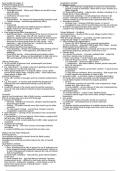Summary
GCSE Geography Pearson Edexcel B Paper 2 summary notes
For the GCSE Pearson Edexcel B Geography the notes provided are a one page summary for the paper 2 which your GCSEs will be on (if you are sitting this specification) These summaries are great as they not only cover all the content you need, but they also contain all the necessary case studies w...
[Show more]



